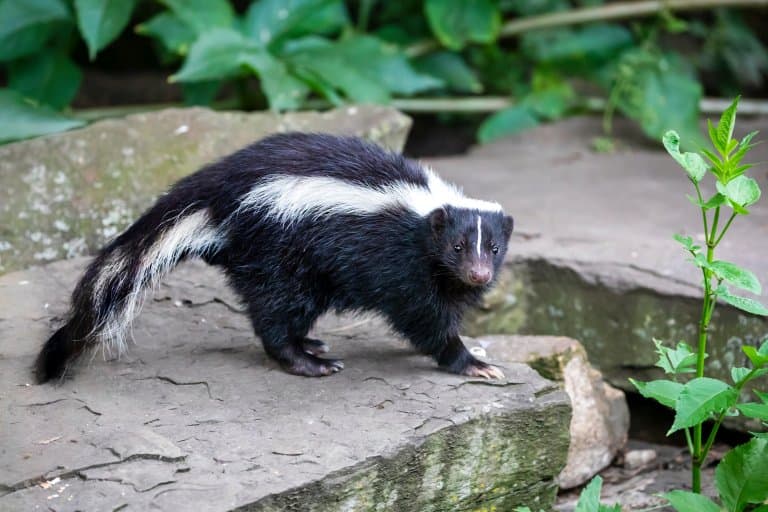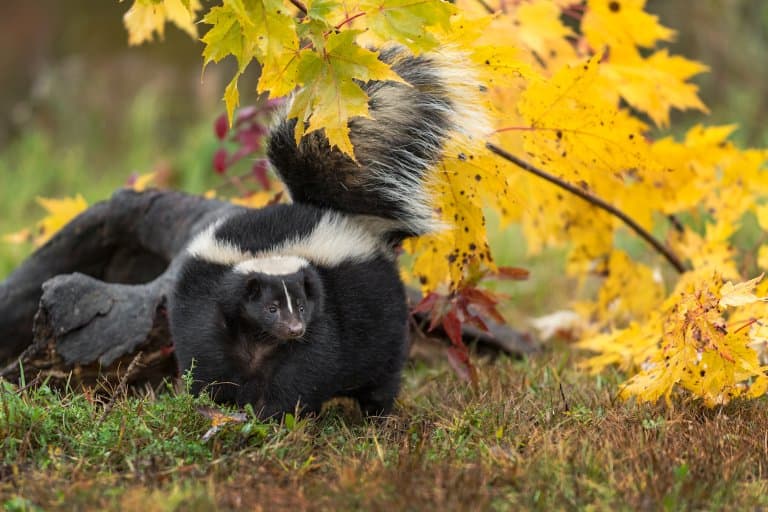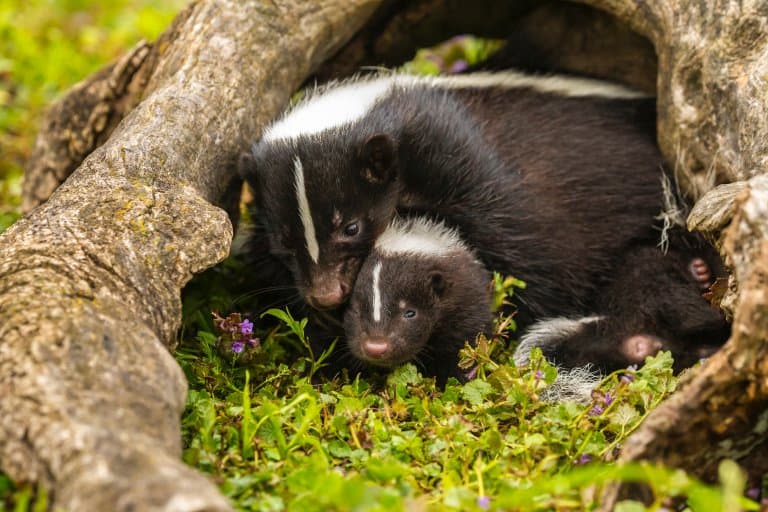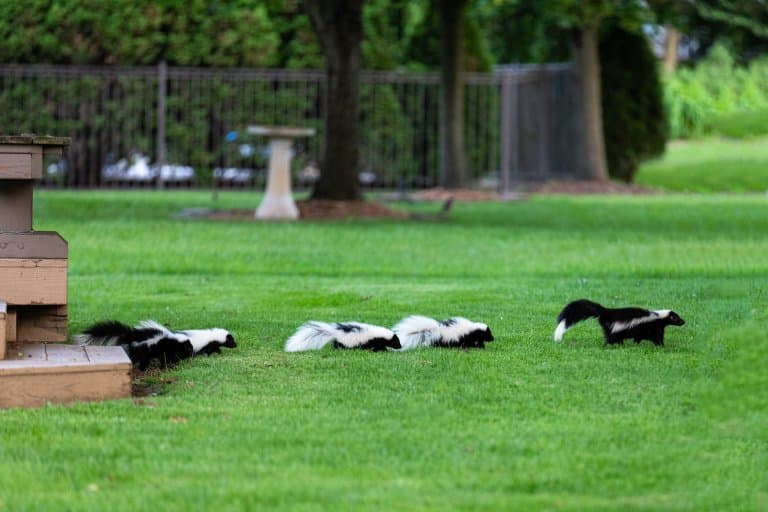Skunk Profile
Skunks are small mammals with black and white stripes, that are notorious due to their ability to spray a disgusting smelling liquid from their anal glands to help ward off predators when threatened.
Skunks have a large range in the world and can be found in Canada, the USA, South America and Mexico.

Skunk Facts Overview
| Habitat: | Woodlands, grasslands, deserts and rocky mountainous areas. Some are also found in the Philippines and on Indonesian Islands |
| Location: | Canada to South America |
| Lifespan: | 7 years in the wild & 10 years in captivity |
| Size: | 40-80cm plus up to another 35cm tail |
| Weight: | 200g – 4.5kg |
| Color: | Generally black/brown and white with distinct patterns of stripes or spots |
| Diet: | Omnivorous – insects, worms, eggs, vegetation, fungi but also some small invertebrates and birds |
| Predators: | Coyotes, foxes, pumas, civets, American badgers, lynx, eagles and owls (young are more likely to be predated upon) |
| Top Speed: | 15 kph (10 mph) |
| No. of Species: |
10 |
| Threats: |
Mainly humans – linked to the threat of rabies and also skunks can eat chickens and eggs. They can be killed because people do not like their smell. Some used to be killed for their fur |
| Conservation Status: |
Least Concern (although some species in certain regions are listed as vulnerable, such as the pygmy spotted skunk and the eastern spotted skunk) |
Skunks used to be classified with the Mustelidae family of weasels, polecats, ferrets and related animals. Although some taxonomies still classify them in this way, more recent genetic evidence shows that they aren’t as closely related to mustelids as previously thought.
Their closest living relatives are stink badgers, who more recently were found to belong to the skunk family, are found in Indonesia and the Philippines.
Skunks have fairly stocky, muscular bodies with relatively short legs. They have long noses and well developed claws. Their dense fur extends across their whole bodies and tails and they are well known for their striking fur colouration and patterning,
The distinctive fur of skunks can range from black/white to brown/white and even to grey and cream. It has bold striped or spotted patterning and is the first signal to would be predators that this isn’t an animal to mess with.
There are 10 living species of skunk today and their size can vary greatly. One of the smaller species is the pygmy spotted skunk, which grows to between 10-35cm, and the largest of the species is the hog-nosed skunk which can grow up to nearly a 1m in length.
Skunks like to sleep in burrows during the day and often take up residence in one that has been previously occupied, although they can dig them out themselves. Skunks inhabit many different terrains, ranging from more open forests to rocky landscapes and even land that is used for agriculture. Some of the stink badger species have even been found in caves.
Skunks are omnivores and will eat insects, worms, grubs, rodents, leaves, berries and fruit dependeing on food availability of the seasons. They will also eat garbage left by humans!
Interesting Skunk Facts
1. Skunks can spray their foul smelling liquid up to 3m
One of the most well known facts regarding skunks is that they excrete a disgusting smelling oily liquid from their anal glands while lifting their tail towards the threat.
Some species can spray this up to 3m away. Skunks often aim the liquid towards the eyes of its predator and can even rotate their body into a ‘U’ shape so they can aim and keep an eye on their threat at the same time.
Their foul spray is enough to ward off large predators such as bears, but interestingly owls are still able to prey on skunks, as they lack a sense of smell. 1
2. The odour of a skunk is so bad, humans can smell it up to 3.5 miles (5.6 km) away
Skunks carry enough of the liquid for 5-6 successive sprays. They need 10 days to produce another supply.
3. Their spray is highly flammable
Skunks have two anal glands which produce their spray, which is a mixture of sulfur-containing chemicals, including thiols.
Thiols makes their liquid highly flammable. So don’t light a match if you’ve been sprayed!

4. Skunks can’t see objects more than 10-feet away
Skunks have poor eyesight, which make them vulnerable to road traffic. Although skunks do not have a great eyesight, their sense of smell and hearing are extremely acute.
They use their well-developed sense of smell when searching for food, especially when rooting around in the earth and their strong hearing system comes in handy when listening out for predators.

5. Some skunks like to climb trees
Some species of spotted skunk, such as the eastern spotted skunk, are agile enough to climb trees. They use this skill well to avoid danger or to find different food stuffs.
6. Skunks are one of the main carriers of rabies
In some of the areas that skunks inhabit, they have been found to be one of the main animals that can carry rabies. They are not the only ones. Other common vectors for rabies in similar areas are bats, racoons and foxes.
7. Some skunks like to handstand
It has been observed in some species of skunk that when threatened, they will stand on their front paws in a handstand like position to help ward their foe off.
They can also make grunting noises and stomp their feet to add to their defences.
8. Skunks aren’t precious about their territories
Skunks generally aren’t aggressive towards each other and they do not mark their territories.
Male home ranges can overlap and can be partly shared. Sometimes males become a bit more defensive during the mating seasons.
9. Baby skunks are known as ‘kits’
Skunks mate in early spring, before giving birth around May for a litter between 4-7 kits.

10. Young are vulnerable when born
When skunks are born they do not have any fur and their eyes are still shut.
They can be born in groups of 2-10 individuals (depending on the species) and will be weaned after around 2 months. Because they cannot use their skink glands straight away they rely solely on their mothers to safeguard them.
11. Some species can delay the birth of their young
In some species of skunk, after mating, they can delay the implantation of the fertilised egg in the uterus.
This can be delayed until environmental conditions are most favourable to help give the young the best chance of survival.
12. They like to sleep in the day
Skunks are nocturnal and will escape the heat of the day, if necessary, by sleeping in burrows.
They will then forage for food at night. Although skunks do not go into a deep hibernation, if the climate they are in is more seasonal, they will stay in their dens during the colder months, often in groups to help keep warm.
13. There was thought to be a fifth species of hog-nosed skunk
Until recently there was a hog-nosed skunk named the western/common hog-nosed skunk.
This is now classified as the American hog-nosed skunk, Conepatus leuconotus.
14. They can eat honey bees
Skunks do like to eat insects and included in this are honey bees. They are the primary predator of bees, and use their thick fur to protect themselves from being stung.
When they discover a hive, skunks will often repeatedly visit it to extract the bees, scratching on the hives to encourage the bees to emerge.
15. Skunks like ‘me’ time
Skunks are mainly solitary and like to search for their food alone, although they can inhabit the same den/burrow for warmth. Males generally do not like to share burrows with other males.
16. A group of skunks are called a ‘surfeit’
While they are typically by themselves, they do gather to mate and look after their young.

17. Skunks can be beneficial to humans
Although skunks don’t always have the best reputation, they actually eat some species of insect and rodents that can be a pest to crops and the agricultural industry as a whole.
Some of the smaller species, like the spotted skunk can be particularly efficient at this. 2
18. Skunks only live for a year in the wild on average
Skunks are short-lived in the wild and have a high mortality rate, often not surviving the first year due to weather, disease, predators, parasites or road death.
However, studies have shown they can live up to 7 years in the wild, or 10 years in captivity.
3
19. Tomato juice does not neutralize the skunks odour
Skunks can be common in urban areas and have encounters with dogs. Therefore, there are lots of misconceptions around the removal of skunk odour from domestic dogs.
The Humane Society of the US recommend removing the odour from dogs by using a mixture of diluted hydrogen peroxide, baking soda, and dishwashing liquid.
Skunk Fact-File Summary
Scientific Classification
| Kingdom: | Animalia |
| Phylum: | Chordata |
| Class: | Mammalia |
| Order: | Carnivora |
| Family: | Mephitidae |
| Genus: | Conepatus (hog-nosed skunks) Mephitis (hooded skunks, striped skunks) Spilogale (spotted skunks) |
| Species Names: |
Conepatus chinga – Molina’s hog-nosed skunk Conepatus humboldtii – Humboldt’s hog-nosed skunk Conepatus leuconotus – American hog-nosed skunk Conepatus semistriatus – striped hog-nosed skunk Mephitis macroura – hooded skunk Mephitis mephitis – striped skunk Spilogale angustifrons – southern spotted skunk Spilogale gracilis – western spotted skunk Spilogale putorius – eastern spotted skunk Spilogale pygmaea – pygmy spotted skunk |
Fact Sources & References
- Alina Bradford (2016), “Facts About Skunks“, Live Science.
- Jerry Dragoo, “Natural history“, Britannica.
- Matthew Wund (2005), “Skunks and Stink Badgers“, Animal Diversity Web.
